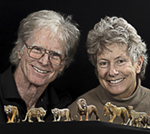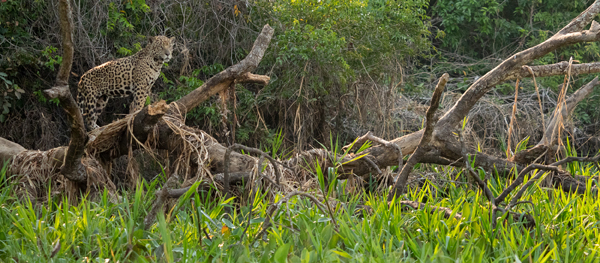
Jaguars and the Wildlife of the Pantanal Photo Tour –
September 2019
Trip Report
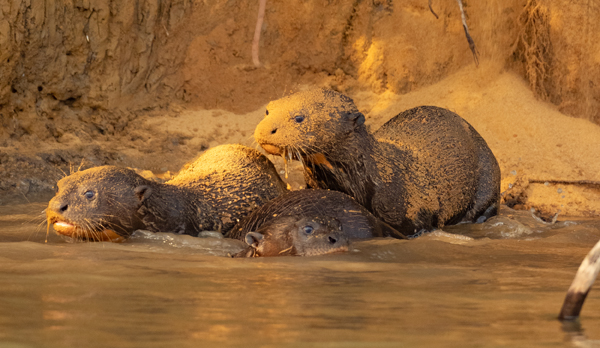
Mary's boat followed, and photographed, a family of Giant Otters for 3k before they
reached their den. The pups played in the sand, sometimes tumbling down to the river
from the entrance of their den.
Photos in this report are by both Joe and Mary Ann McDonald
We love the Pantanal, and this year we were fortunate to do two Photo Tours to this diverse and rich region. One was a private trip, arranged by a friend, which involved 8 participants, and for that trip I did not do a Trip Report. About 5 weeks later we did our second, 'official' photo tour, which is the subject of this report.
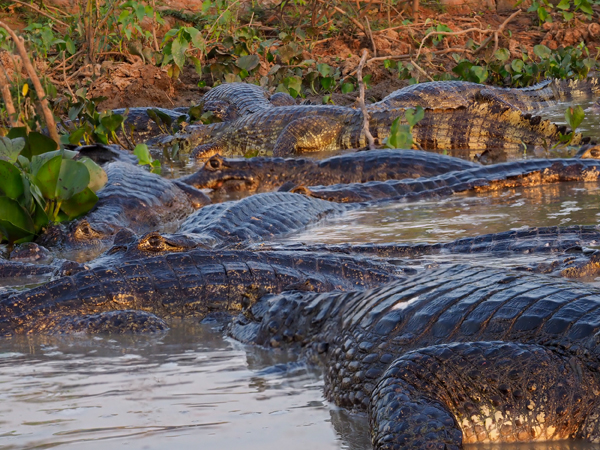
On our July trip Yacare Caimans were bubble dancing, a territorial/courtship display. In September
the displays were rare, but with falling water levels hundreds of Caimans gathered in a shallow
pool to catch fish. This happened at dawn, and by 8:30AM that same pond seemed empty, not a
Caiman in sight. This shot was done with FOCUS STACKING in camera using my Olympus M1X, with a 600mm lens. Check out the depth -- every Caiman is in focus.
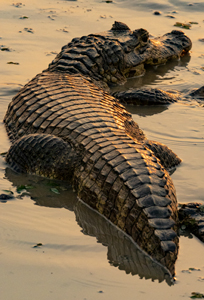 What was very interesting was the subtle changes we saw in that short time. The photo above is the perfect example. In July the water levels at one of our favorite ponds was high, and Caimans were swimming about, occasionally doing their territorial displays, the 'bubble dance.' Black Skimmers were skimming, giving us incredible flight opportunities. But in September the Skimmmers were rare, and the water level was low. One dawn, as we headed out to look for Anteaters, we saw that the now shallow pond was virtually covered in Caimans. They had gathered to catch the fish trapped in the shallow water. There were hundreds, and it was challenging to concentrate on any one subject, so much was going on. We spent nearly two hours there before we headed back to our lodge for breakfast. An hour later, around 8:30AM, we passed the same pond, which was now empty of the Caimans!
What was very interesting was the subtle changes we saw in that short time. The photo above is the perfect example. In July the water levels at one of our favorite ponds was high, and Caimans were swimming about, occasionally doing their territorial displays, the 'bubble dance.' Black Skimmers were skimming, giving us incredible flight opportunities. But in September the Skimmmers were rare, and the water level was low. One dawn, as we headed out to look for Anteaters, we saw that the now shallow pond was virtually covered in Caimans. They had gathered to catch the fish trapped in the shallow water. There were hundreds, and it was challenging to concentrate on any one subject, so much was going on. We spent nearly two hours there before we headed back to our lodge for breakfast. An hour later, around 8:30AM, we passed the same pond, which was now empty of the Caimans!
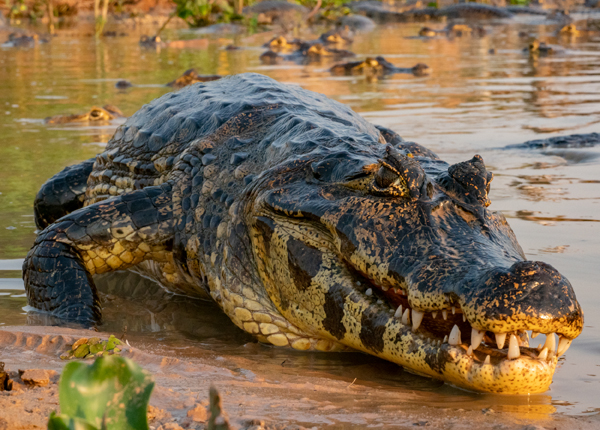
A hungry Caiman, at 114mm. I was sitting on the edge of the pond, using a RRS Pocket Pod,
with a BH25-Pro ballhead. That little tripod is small enough to fit into the outside flap of my
photo backpack, and is perfect for low-level work. I've used the Pocket Pod with my 300mm
and M1X camera - equivalent of 600mm - so it is sturdy!
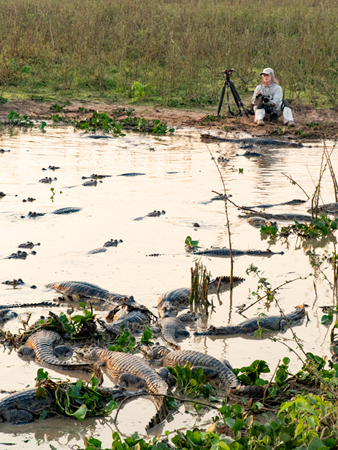
My legs were sticking out in front of me, and I guess my feet looked a bit like fish (looked,
not smelled!), as several Caimans came curiously close. Rather than laying flat on my belly
in the mud, I could use either the Pocket Pod or my knee as a support, courtesy of the
flip-out screen.
This one example illustrates how every trip is completely different, each with its own incredible highlights and unique subject matter. We never get tired of this area, as every river bend or turn on a dirt track offers the promise of an incredible experience'
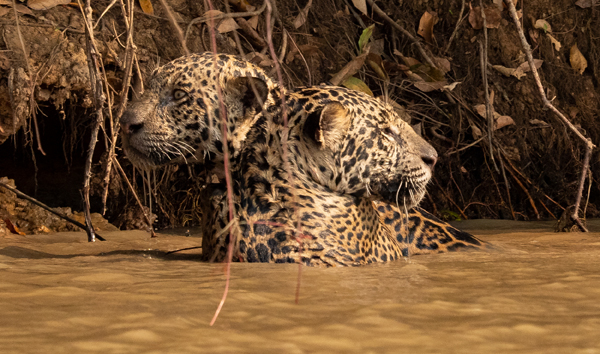
A two-headed Jaguar? No, but this pair, two males, have been together since they left their
mother's care last year. We've followed the two for years, and it will be interesting to see if
they stay associated as they get older and can challenge resident males for breeding rights.
We're learning more and more about what was once a very secretive and little known cat,
and personally, I won't be surprised if these two will, at least occasionally, stay in contact.
When I first visited the Pantanal on a scouting trip nearly 12 years ago, my boat was one of only two on the river searching for Jaguars. Back then, it took my friends and I three days before we saw the first of 7 or 8 Jaguars we saw during that trip. Times have changed. Now, over 20 boats might be gathered at a Jaguar sighting, but we typically see over 20 Jaguars in 4 or 5 days. This year, on this trip, some in our group saw 9 Jaguars in just one day! While some sightings are crowded and somewhat frustrating, I must say that the boatmen on the river have become quite cooperative with one another, doing their best to insure that no one cuts off one another. While shooting is sometimes compromised, it is rare that photographers don't get some great shots, regardless. Of course, we're all greedy and want to get ALL the shots .....
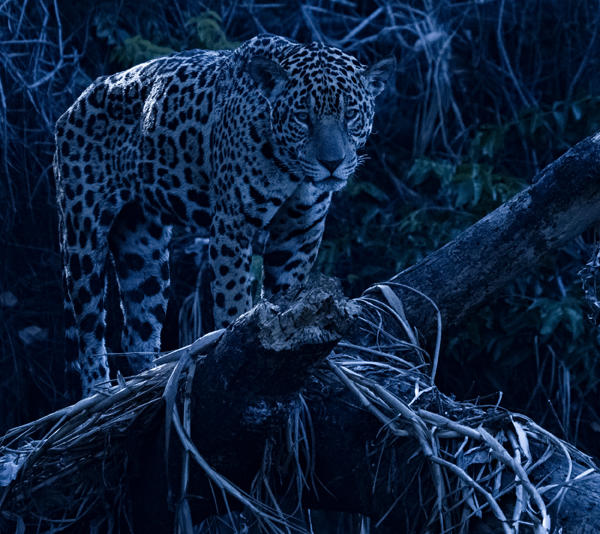
A Jaguar in the moon light!
Well, not really -- I used the tools in the RAW converter to turn daylight into moonlight. Although
I taught the RAW converter in our Nature Photo Classes, next year I won't be offered this course.
However, we still do private sessions of 1 or 2 days, if you're interested.
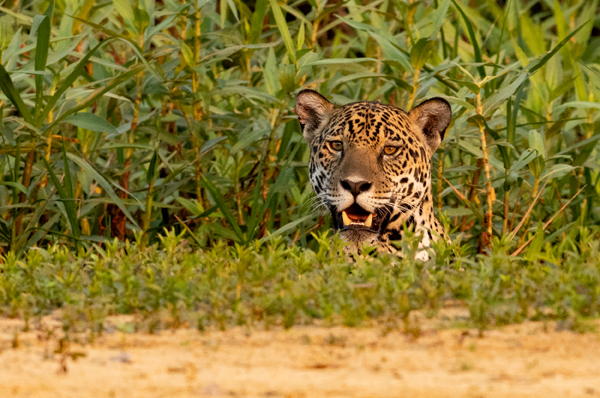
While we get plenty of full body shots, this one of a Jaguar peeking over a sand bank is
particularly appealing. Her name is Pace, and she was just a few minutes downriver from
the flotel where our group stays while in Jaguar land.
In contrast to several other tour companies visiting the Pantanal, our groups stay on a 'flotel,' a large boat that is anchored in the heart of Jaguar country. Most groups stay in Porto Joffre and one of the hotels located there, which entails a 25-40 minute boat ride to reach the same area where we're anchored. Our outfitter, South Wild, also has several camps or lodges where our group visit, giving us a very broad experience in the Pantanal.
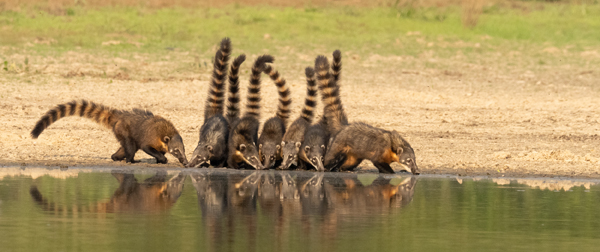
Some of the subjects at the Jaguar Lake were distant. I used my Olympus Zuiko 300mm lens
with a 2X tele-converter, giving me the equivalent of 1200mm!
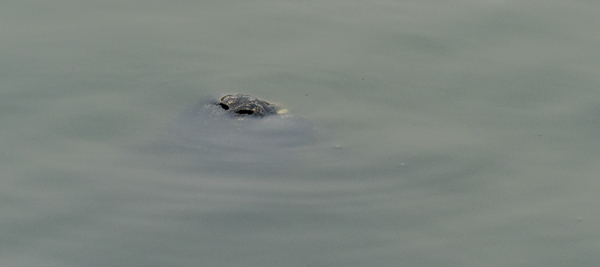
What's the big deal here? Well, it is the snout of a Caiman that periodically rose to
the surface, took a breath, and disappeared again. We
were on the shooting platform and
were astounded each time we saw the snout. While Jacare Caimans aren't dangerous, this
behavior would be the same for dangerous Nile and Salt-Water Crocodiles (African and
Austro-Asian species, respectively), and someone visiting a lake or river wouldn't have
a clue that a major predator was lurking nearby. It was an instructive moment for me.
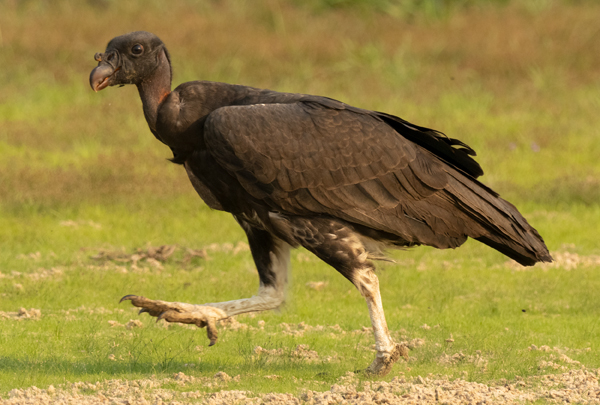
Immature King Vulture that trotted around the pond!
This year I had the opportunity to explore a new area that South Wild, our outfitter, offers as a stand-alone trip or as an add-on. Called Jaguar Lake, the camp is small, set up for only a few people, and two participant/friends joined me for an afternoon visit. Our time was spent on a shooting platform in the lake where we hoped Jaguars, Giant Anteaters, and Tapirs would appear for a drink. Tapirs did, but the other two subjects did not, but we still had an interesting time on the platform. Success, here, is partially a matter of luck, as it is with all wildlife photography, but is also contingent upon the lake's water level. Too much water, and subjects might be too far away, and too little makes moving the floating shooting platform impossible. We had the latter, so our shooting was fixed. We were lucky in some of our subjects, Coatis, King Vultures, Aplomado Falcons, and Brazilian Tapirs visited the pond close to our platform, and we succeeded in getting some interesting shots. Our luck could have run the other way, of course, with all of our subjects visiting the pond at the far back end, with our lenses aimed into the light, but we were lucky. My Brazilian guide visited the pond a week or two later and had a Maned Wolf visit the pond, as well as several other great subjects, while a small group that preceded his visit had little action. So, you never know, but I'd happily go back for an afternoon visit again, next year, on our next series of tours.
Instead of a lengthy text, I'll give more lengthy captions to tell the story of this incredible photo tour..
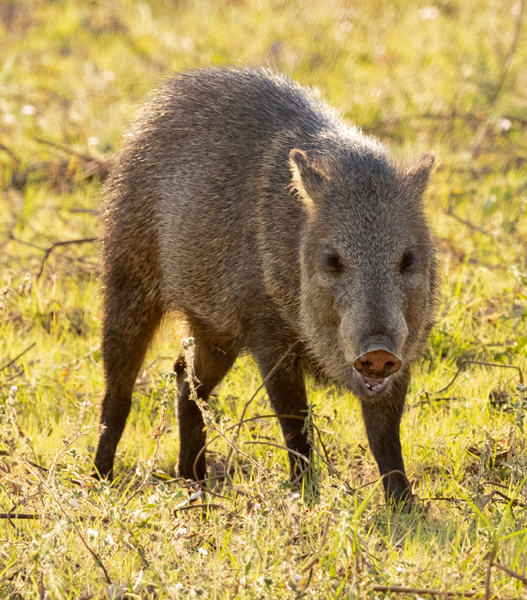
Our tour started auspiciously when we had a herd of Collared Peccary in an open field.
Normally shy, these distant pig relatives were out in the late afternoon.
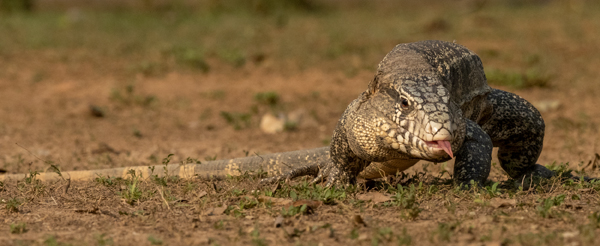
Manners count. Our Photo Group was lined up and at a distance as this male Tegu walked towards
us. Another group, bird-watchers and nature lovers (I guess) were nearby, and two 'shooters'
walked right up towards the Tegu, causing it to turn tail and run. That was so rude ... anyone
could see what 6 photographers were doing, yet the rudeness of these tourists not only
spoiled a nice shooting opportunity but also completely disrupted the animal's path.
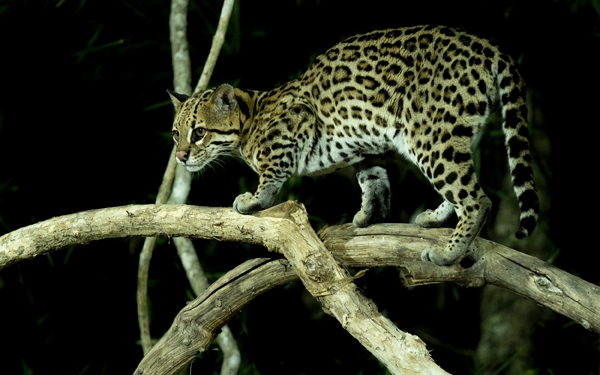
In previous years we had to use multiple flashes to obtain natural-looking shots of this
nocturnal Ocelot that frequently visits a bait site. Our lodge has installed LED lights that
makes flash unnecessary, and makes for some great shots
.
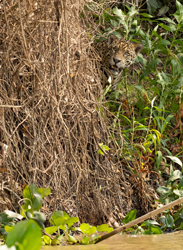
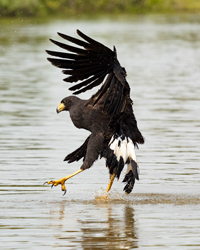
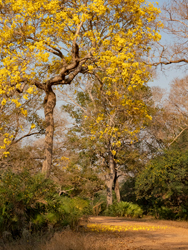
Jaguar in a hunt; Great Black Hawk; Epe' tree in flower
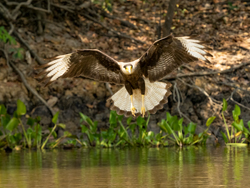
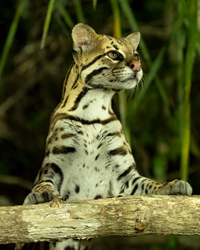
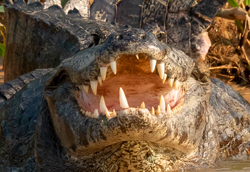
Southern Crested Caracara; ocelot; Yacare' Caiman
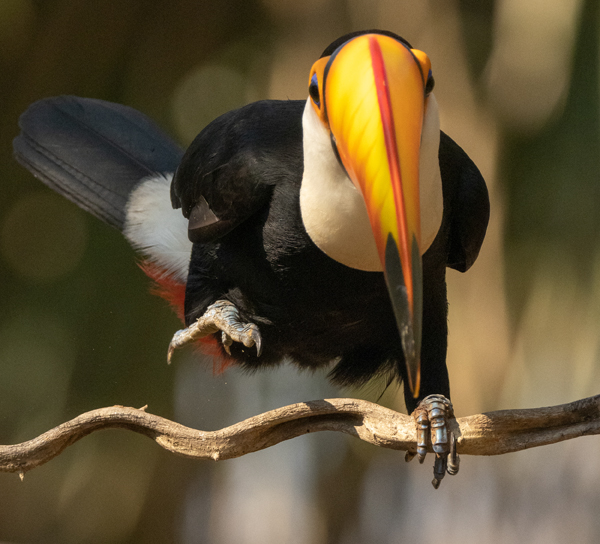
We have Toco Toucans at several sites, and at one of our lodges a natural-looking
bait site provides for wonderful shooting opportunities.
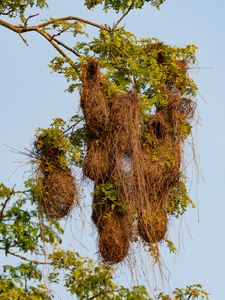
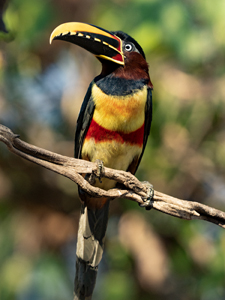
Yellow-rumped Cacique nests; Chestnut-eared Aracari
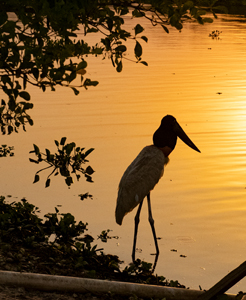
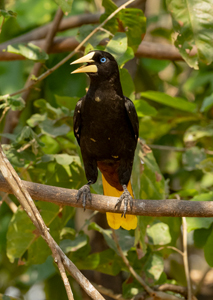
Jabiru Stork; Crested Oropendola
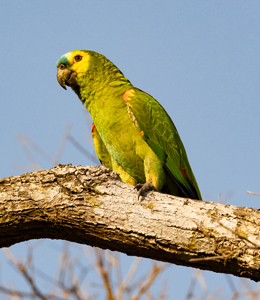
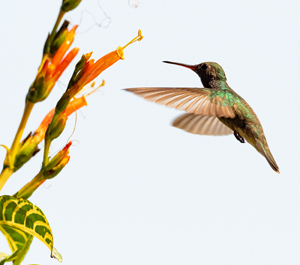
Turquoise-fronted Parrot; Glittering-bellied Hummingbird
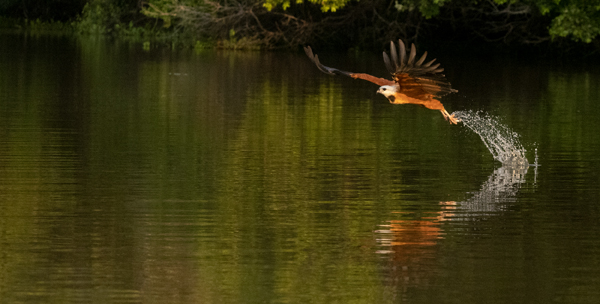
Black-collared Hawks swoop down for fish.
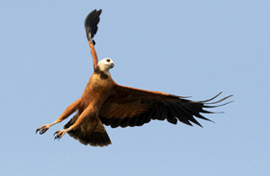
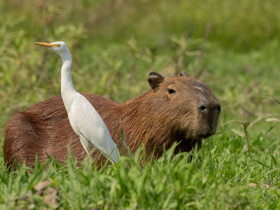
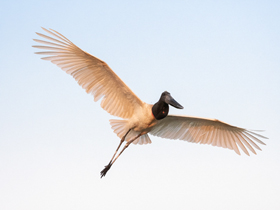
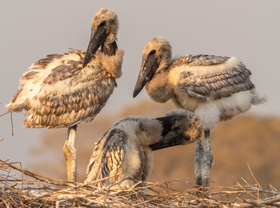
Black-collared hawk; Cattle Egret and Capybara;
Jabiru Stork adult and chicks at the nest.
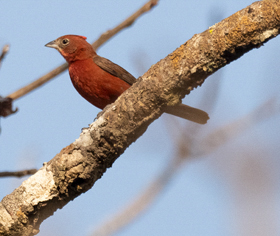
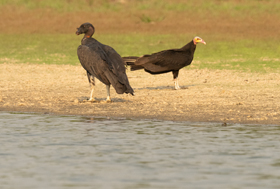
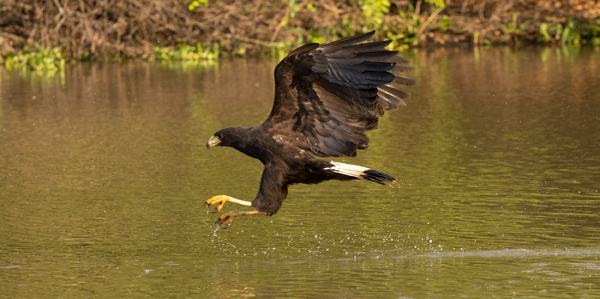
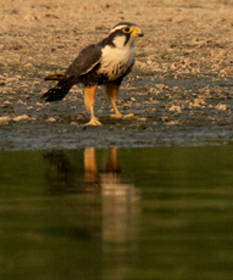
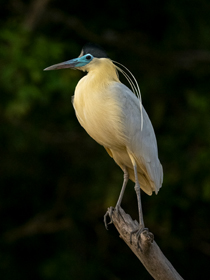
Red-pileated Finch; King Vulture and Lesser Yellow-headed Vulture;
Great Black Hawk;
Aplomado Falcon; Capped Heron
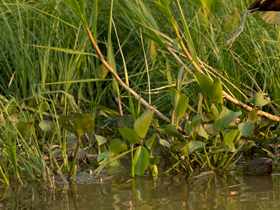
Here's the shot I caught, with my lightning-fast reaction time.
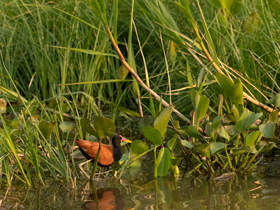
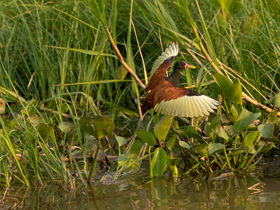
Here's what I captured using ProCapture, where I had 15 pre-shutter release shots.
The Wattled Jacana in flight was just one of 12, caught in various flight poses,
while the non-flying bird represents the first shot in the series.
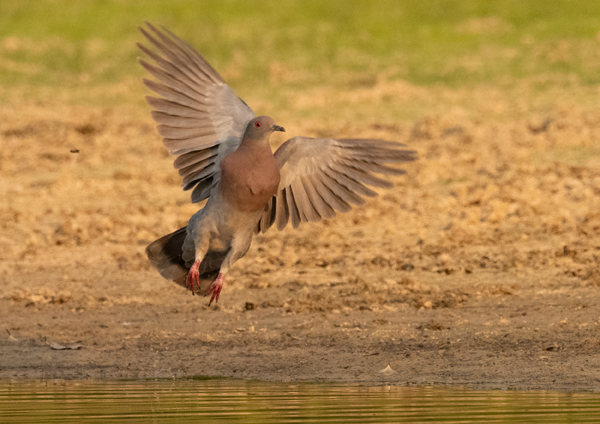
Pale-vented Pigeon at launch, via ProCapture
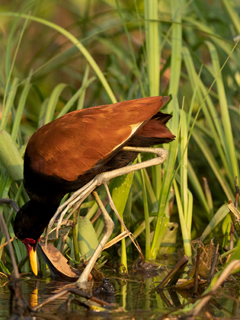
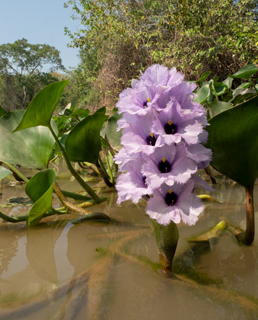
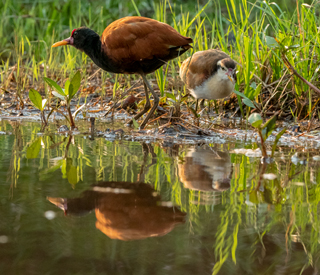
With the flip-out screen of the Olympus cameras I could hang over the
boat and position the camera just above the water level, all the while
checking focus and straightness (no tilted water!) while doing so.
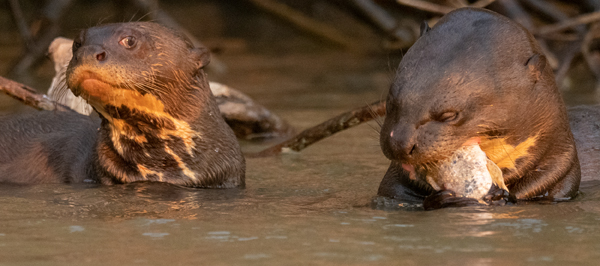
If this young Giant Otter looks a bit wiley, it was! Seconds after ths shot the juvenile grabbed
the fish from this adult's jaws in a splashing frenzy of activity.
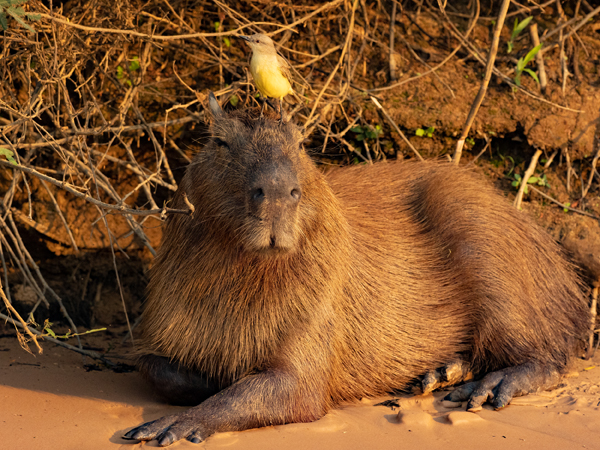
Cattle Tyrant and Capybara - the bird will not only use the world's largest rodent as a perch
for hunting, but will look for insects in the fur, or that land on this moving platform.
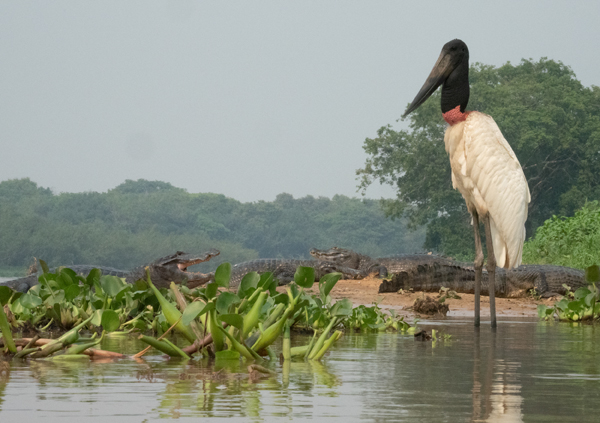
Jabiru Stork and Caimans. Too often, photographers only 'see' the subject, the most prominent
target. Zooming out and including habitat truly captures the essense of the Pantanal and
tells a far more effective story.
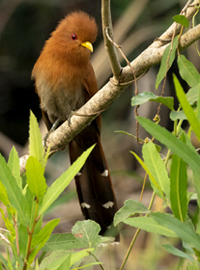
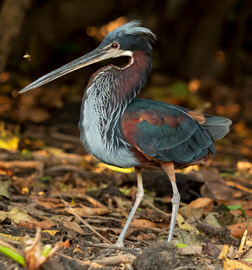
Little Cuckoo; Agami Heron - one of the true trophy birds of the Pantanal

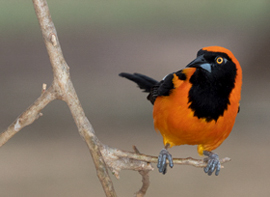
Black-collared hawk; Orange-backed Troupial
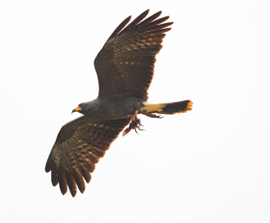
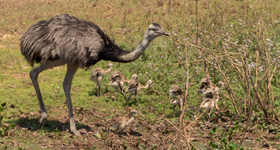
Snail Kite and Pantanal fresh-water crab; Rhea and 13 chicks
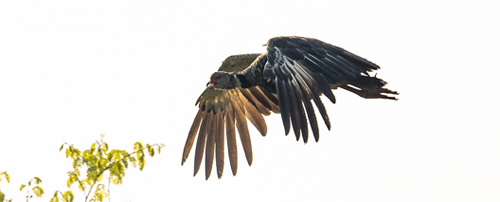
Southern Screamer. You don't often get a chance to shoot this bird in flight, but
Mary nailed it. Note the spur at the elbow of the wing -- this is a formidable
defensive weapon.
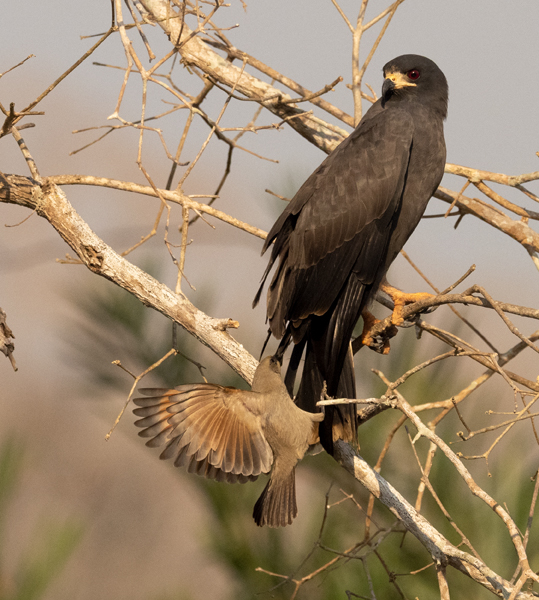
Snail Kite being harassed by a Baywing (a type of Blackbird). I was using ProCapture
and I'd fire as the bird struck or appeared in the frame. This happened so fast that
I missed the bird in my 'true' shot, but the pre-shutter shots caught the action
multiple times.

Brazilian Tapir at 1/125th sec, ISO 1600 - we had seconds before the Tapir disappeared.


Brocket Deer at the Jaguar Lake; Howler Monkey on the main river from the Flotel
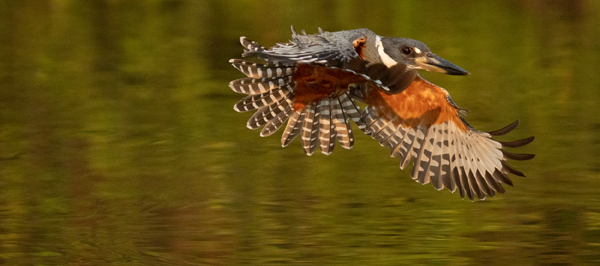
Ringed Kingfisher swooping by before diving for a fish. Although the non-Olympus shooters
captured several great shots, by using ProCapture Mary and I caught multiple poses as
the Kingfishers presented themselves.
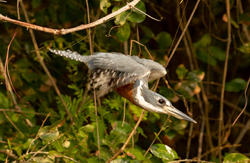
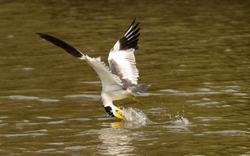
We had multiple opportunities to photograph Ringed and Amazon Kingfishers,
Large-billed Terns, hawks and caracaras, and other birds on our special
boat trips at our land-based lodge.
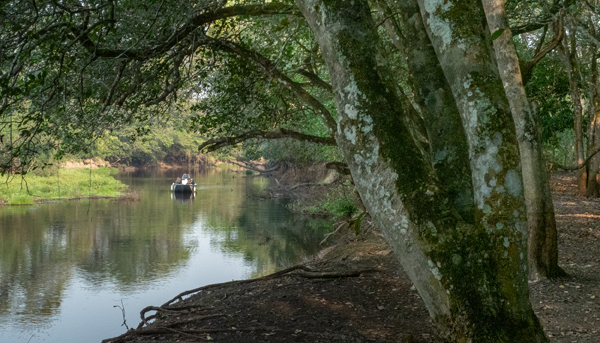
This slow-moving river is one of our favorite locations for shooting. The current is slow, so
it is easy to frame and compose, in contrast to the more challenging conditions on the faster
flowing rivers. The Dynamic Range of the Olympus cameras is really impressive, and by
effective use of the RAW converter tools I could convey what my eyes saw.
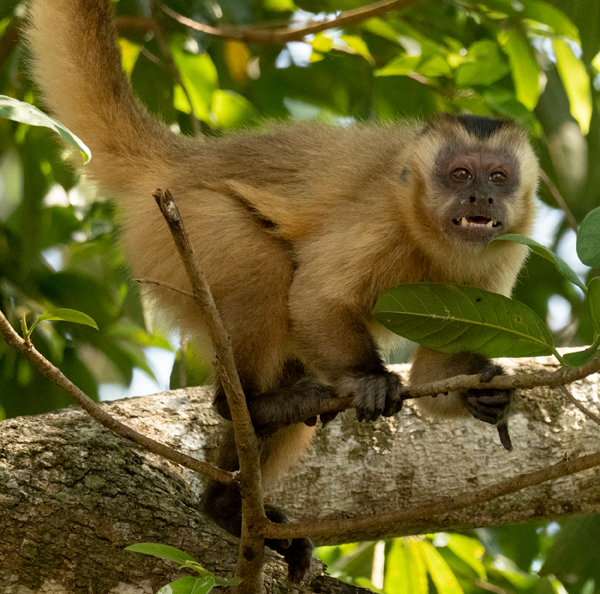
Capuchin Monkey at one of our lodges. We had Monkeys at several locations, and at this lodge
we had nearly an hour of shooting as the Monkeys fed on the fruits from this tree.
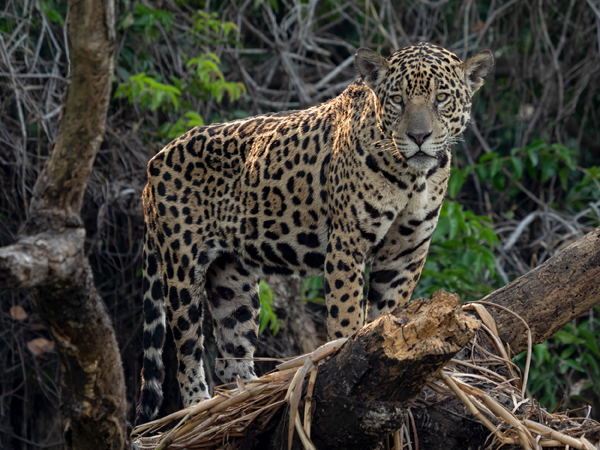
We had approximately 25 Jaguar encounters on this tour, including courting pairs, Jaguars
swimming, hunting, walking along the river banks, resting, grooming, and more. On the first
afternoon in jaguar country we had this Jaguar on a log, one of the iconic images that, until
last year, always eluded me. Getting this on our first afternoon really took the pressure off
of us -- not that we worried about getting Jaguars -- and allowed us to sometimes pass on
crowded encounters or sleeping cats to seek other subjects. We were always rewarded for
doing so!
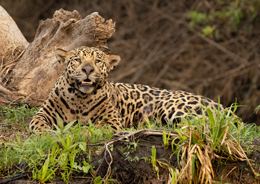
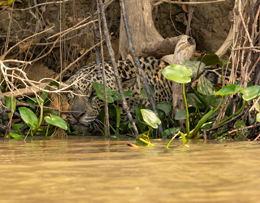
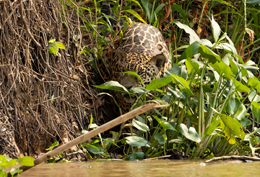
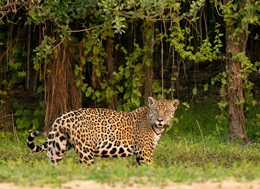
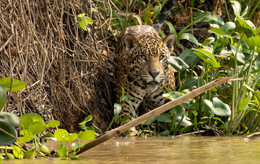
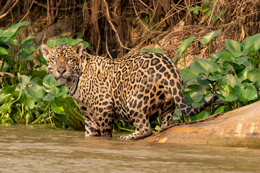
Here's a brief portfolio of Mary's Jaguars, representative of the hundreds of images
Mary and I shot, which were probably far fewer than our participants shooting
Jaguars for the first time.
As usual, the trip was incredible. So many memories, and so many wonderful observations. One example, Mary's boat followed a family of Giant Otters for over an hour, with the otters swimming, with their cubs or pups, for at least 3 kilometers until they reached the sandy river bank where they had a den.
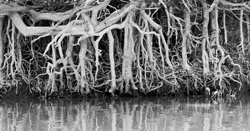 In contrast to many tours, we use just two boats - big enough to provide wonderful stability when shooting, fast enough to get us where we need to be, but, more importantly, using two boats allow us to have TWO LEADERS, Mary in one, and me in the other, to guide our group. Honestly, I can't imagine tourists or photographers visiting this area for the first time not being with their leader. While Jaguars are certainly the primary focus for everyone, there is so many great subjects to shoot, but would a novice know how special it is to wait on a Crane Hawk hunting for frogs, or how beautiful a Capped Heron truly is, and how difficult it can be to get a great image of one, and simply motor on by in their obsession with getting a Jaguar photograph. Our groups get the Jaguar shots, but we also capture all of the beauty and wonder of the Pantanal, as I hope this portfolio shows.
In contrast to many tours, we use just two boats - big enough to provide wonderful stability when shooting, fast enough to get us where we need to be, but, more importantly, using two boats allow us to have TWO LEADERS, Mary in one, and me in the other, to guide our group. Honestly, I can't imagine tourists or photographers visiting this area for the first time not being with their leader. While Jaguars are certainly the primary focus for everyone, there is so many great subjects to shoot, but would a novice know how special it is to wait on a Crane Hawk hunting for frogs, or how beautiful a Capped Heron truly is, and how difficult it can be to get a great image of one, and simply motor on by in their obsession with getting a Jaguar photograph. Our groups get the Jaguar shots, but we also capture all of the beauty and wonder of the Pantanal, as I hope this portfolio shows.
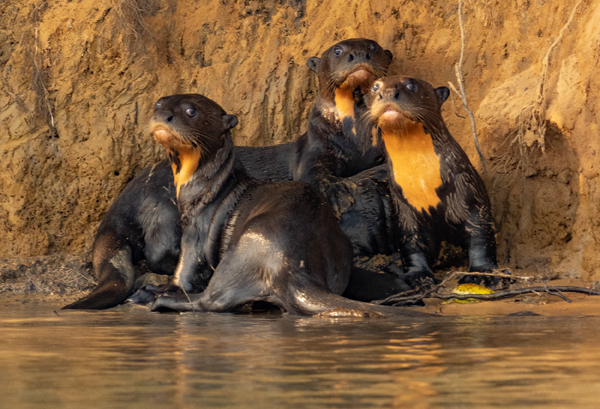
The Giant Otter family, waiting to see YOU next year with us!
Why you should travel with us
Testimonials
Check out the prices -
Olympus Official Store
Featured on ShotKit - read the interview
Join us on Facebook at: Follow Hoot Hollow
Office Phone: (717) 543-6423
Or FAX us at: (717) 543-5342
Mary and Joe are proud to endorse the Photo Retailer that has
done the absolute most in supporting nature photography in all
its facets ---

Check out the Monthly Specials
from Hunt's

Jaguars and the Wildlife of the Pantanal Photo Tour –
September 2019
Trip Report

Mary's boat followed, and photographed, a family of Giant Otters for 3k before they
reached their den. The pups played in the sand, sometimes tumbling down to the river
from the entrance of their den.
Photos in this report are by both Joe and Mary Ann McDonald
We love the Pantanal, and this year we were fortunate to do two Photo Tours to this diverse and rich region. One was a private trip, arranged by a friend, which involved 8 participants, and for that trip I did not do a Trip Report. About 5 weeks later we did our second, 'official' photo tour, which is the subject of this report.

On our July trip Yacare Caimans were bubble dancing, a territorial/courtship display. In September
the displays were rare, but with falling water levels hundreds of Caimans gathered in a shallow
pool to catch fish. This happened at dawn, and by 8:30AM that same pond seemed empty, not a
Caiman in sight. This shot was done with FOCUS STACKING in camera using my Olympus M1X, with a 600mm lens. Check out the depth -- every Caiman is in focus.
 What was very interesting was the subtle changes we saw in that short time. The photo above is the perfect example. In July the water levels at one of our favorite ponds was high, and Caimans were swimming about, occasionally doing their territorial displays, the 'bubble dance.' Black Skimmers were skimming, giving us incredible flight opportunities. But in September the Skimmmers were rare, and the water level was low. One dawn, as we headed out to look for Anteaters, we saw that the now shallow pond was virtually covered in Caimans. They had gathered to catch the fish trapped in the shallow water. There were hundreds, and it was challenging to concentrate on any one subject, so much was going on. We spent nearly two hours there before we headed back to our lodge for breakfast. An hour later, around 8:30AM, we passed the same pond, which was now empty of the Caimans!
What was very interesting was the subtle changes we saw in that short time. The photo above is the perfect example. In July the water levels at one of our favorite ponds was high, and Caimans were swimming about, occasionally doing their territorial displays, the 'bubble dance.' Black Skimmers were skimming, giving us incredible flight opportunities. But in September the Skimmmers were rare, and the water level was low. One dawn, as we headed out to look for Anteaters, we saw that the now shallow pond was virtually covered in Caimans. They had gathered to catch the fish trapped in the shallow water. There were hundreds, and it was challenging to concentrate on any one subject, so much was going on. We spent nearly two hours there before we headed back to our lodge for breakfast. An hour later, around 8:30AM, we passed the same pond, which was now empty of the Caimans!

A hungry Caiman, at 114mm. I was sitting on the edge of the pond, using a RRS Pocket Pod,
with a BH25-Pro ballhead. That little tripod is small enough to fit into the outside flap of my
photo backpack, and is perfect for low-level work. I've used the Pocket Pod with my 300mm
and M1X camera - equivalent of 600mm - so it is sturdy!

My legs were sticking out in front of me, and I guess my feet looked a bit like fish (looked,
not smelled!), as several Caimans came curiously close. Rather than laying flat on my belly
in the mud, I could use either the Pocket Pod or my knee as a support, courtesy of the
flip-out screen.
This one example illustrates how every trip is completely different, each with its own incredible highlights and unique subject matter. We never get tired of this area, as every river bend or turn on a dirt track offers the promise of an incredible experience'

A two-headed Jaguar? No, but this pair, two males, have been together since they left their
mother's care last year. We've followed the two for years, and it will be interesting to see if
they stay associated as they get older and can challenge resident males for breeding rights.
We're learning more and more about what was once a very secretive and little known cat,
and personally, I won't be surprised if these two will, at least occasionally, stay in contact.
When I first visited the Pantanal on a scouting trip nearly 12 years ago, my boat was one of only two on the river searching for Jaguars. Back then, it took my friends and I three days before we saw the first of 7 or 8 Jaguars we saw during that trip. Times have changed. Now, over 20 boats might be gathered at a Jaguar sighting, but we typically see over 20 Jaguars in 4 or 5 days. This year, on this trip, some in our group saw 9 Jaguars in just one day! While some sightings are crowded and somewhat frustrating, I must say that the boatmen on the river have become quite cooperative with one another, doing their best to insure that no one cuts off one another. While shooting is sometimes compromised, it is rare that photographers don't get some great shots, regardless. Of course, we're all greedy and want to get ALL the shots .....

A Jaguar in the moon light!
Well, not really -- I used the tools in the RAW converter to turn daylight into moonlight. Although
I taught the RAW converter in our Nature Photo Classes, next year I won't be offered this course.
However, we still do private sessions of 1 or 2 days, if you're interested.

While we get plenty of full body shots, this one of a Jaguar peeking over a sand bank is
particularly appealing. Her name is Pace, and she was just a few minutes downriver from
the flotel where our group stays while in Jaguar land.
In contrast to several other tour companies visiting the Pantanal, our groups stay on a 'flotel,' a large boat that is anchored in the heart of Jaguar country. Most groups stay in Porto Joffre and one of the hotels located there, which entails a 25-40 minute boat ride to reach the same area where we're anchored. Our outfitter, South Wild, also has several camps or lodges where our group visit, giving us a very broad experience in the Pantanal.

Some of the subjects at the Jaguar Lake were distant. I used my Olympus Zuiko 300mm lens
with a 2X tele-converter, giving me the equivalent of 1200mm!

What's the big deal here? Well, it is the snout of a Caiman that periodically rose to
the surface, took a breath, and disappeared again. We
were on the shooting platform and
were astounded each time we saw the snout. While Jacare Caimans aren't dangerous, this
behavior would be the same for dangerous Nile and Salt-Water Crocodiles (African and
Austro-Asian species, respectively), and someone visiting a lake or river wouldn't have
a clue that a major predator was lurking nearby. It was an instructive moment for me.

Immature King Vulture that trotted around the pond!
This year I had the opportunity to explore a new area that South Wild, our outfitter, offers as a stand-alone trip or as an add-on. Called Jaguar Lake, the camp is small, set up for only a few people, and two participant/friends joined me for an afternoon visit. Our time was spent on a shooting platform in the lake where we hoped Jaguars, Giant Anteaters, and Tapirs would appear for a drink. Tapirs did, but the other two subjects did not, but we still had an interesting time on the platform. Success, here, is partially a matter of luck, as it is with all wildlife photography, but is also contingent upon the lake's water level. Too much water, and subjects might be too far away, and too little makes moving the floating shooting platform impossible. We had the latter, so our shooting was fixed. We were lucky in some of our subjects, Coatis, King Vultures, Aplomado Falcons, and Brazilian Tapirs visited the pond close to our platform, and we succeeded in getting some interesting shots. Our luck could have run the other way, of course, with all of our subjects visiting the pond at the far back end, with our lenses aimed into the light, but we were lucky. My Brazilian guide visited the pond a week or two later and had a Maned Wolf visit the pond, as well as several other great subjects, while a small group that preceded his visit had little action. So, you never know, but I'd happily go back for an afternoon visit again, next year, on our next series of tours.
Instead of a lengthy text, I'll give more lengthy captions to tell the story of this incredible photo tour..

Our tour started auspiciously when we had a herd of Collared Peccary in an open field.
Normally shy, these distant pig relatives were out in the late afternoon.

Manners count. Our Photo Group was lined up and at a distance as this male Tegu walked towards
us. Another group, bird-watchers and nature lovers (I guess) were nearby, and two 'shooters'
walked right up towards the Tegu, causing it to turn tail and run. That was so rude ... anyone
could see what 6 photographers were doing, yet the rudeness of these tourists not only
spoiled a nice shooting opportunity but also completely disrupted the animal's path.

In previous years we had to use multiple flashes to obtain natural-looking shots of this
nocturnal Ocelot that frequently visits a bait site. Our lodge has installed LED lights that
makes flash unnecessary, and makes for some great shots
.



Jaguar in a hunt; Great Black Hawk; Epe' tree in flower



Southern Crested Caracara; ocelot; Yacare' Caiman

We have Toco Toucans at several sites, and at one of our lodges a natural-looking
bait site provides for wonderful shooting opportunities.


Yellow-rumped Cacique nests; Chestnut-eared Aracari


Jabiru Stork; Crested Oropendola


Turquoise-fronted Parrot; Glittering-bellied Hummingbird

Black-collared Hawks swoop down for fish.




Black-collared hawk; Cattle Egret and Capybara;
Jabiru Stork adult and chicks at the nest.





Red-pileated Finch; King Vulture and Lesser Yellow-headed Vulture;
Great Black Hawk;
Aplomado Falcon; Capped Heron

Here's the shot I caught, with my lightning-fast reaction time.


Here's what I captured using ProCapture, where I had 15 pre-shutter release shots.
The Wattled Jacana in flight was just one of 12, caught in various flight poses,
while the non-flying bird represents the first shot in the series.

Pale-vented Pigeon at launch, via ProCapture



With the flip-out screen of the Olympus cameras I could hang over the
boat and position the camera just above the water level, all the while
checking focus and straightness (no tilted water!) while doing so.

If this young Giant Otter looks a bit wiley, it was! Seconds after ths shot the juvenile grabbed
the fish from this adult's jaws in a splashing frenzy of activity.

Cattle Tyrant and Capybara - the bird will not only use the world's largest rodent as a perch
for hunting, but will look for insects in the fur, or that land on this moving platform.

Jabiru Stork and Caimans. Too often, photographers only 'see' the subject, the most prominent
target. Zooming out and including habitat truly captures the essense of the Pantanal and
tells a far more effective story.


Little Cuckoo; Agami Heron - one of the true trophy birds of the Pantanal


Black-collared hawk; Orange-backed Troupial


Snail Kite and Pantanal fresh-water crab; Rhea and 13 chicks

Southern Screamer. You don't often get a chance to shoot this bird in flight, but
Mary nailed it. Note the spur at the elbow of the wing -- this is a formidable
defensive weapon.

Snail Kite being harassed by a Baywing (a type of Blackbird). I was using ProCapture
and I'd fire as the bird struck or appeared in the frame. This happened so fast that
I missed the bird in my 'true' shot, but the pre-shutter shots caught the action
multiple times.

Brazilian Tapir at 1/125th sec, ISO 1600 - we had seconds before the Tapir disappeared.


Brocket Deer at the Jaguar Lake; Howler Monkey on the main river from the Flotel

Ringed Kingfisher swooping by before diving for a fish. Although the non-Olympus shooters
captured several great shots, by using ProCapture Mary and I caught multiple poses as
the Kingfishers presented themselves.


We had multiple opportunities to photograph Ringed and Amazon Kingfishers,
Large-billed Terns, hawks and caracaras, and other birds on our special
boat trips at our land-based lodge.

This slow-moving river is one of our favorite locations for shooting. The current is slow, so
it is easy to frame and compose, in contrast to the more challenging conditions on the faster
flowing rivers. The Dynamic Range of the Olympus cameras is really impressive, and by
effective use of the RAW converter tools I could convey what my eyes saw.

Capuchin Monkey at one of our lodges. We had Monkeys at several locations, and at this lodge
we had nearly an hour of shooting as the Monkeys fed on the fruits from this tree.

We had approximately 25 Jaguar encounters on this tour, including courting pairs, Jaguars
swimming, hunting, walking along the river banks, resting, grooming, and more. On the first
afternoon in jaguar country we had this Jaguar on a log, one of the iconic images that, until
last year, always eluded me. Getting this on our first afternoon really took the pressure off
of us -- not that we worried about getting Jaguars -- and allowed us to sometimes pass on
crowded encounters or sleeping cats to seek other subjects. We were always rewarded for
doing so!






Here's a brief portfolio of Mary's Jaguars, representative of the hundreds of images
Mary and I shot, which were probably far fewer than our participants shooting
Jaguars for the first time.
As usual, the trip was incredible. So many memories, and so many wonderful observations. One example, Mary's boat followed a family of Giant Otters for over an hour, with the otters swimming, with their cubs or pups, for at least 3 kilometers until they reached the sandy river bank where they had a den.
 In contrast to many tours, we use just two boats - big enough to provide wonderful stability when shooting, fast enough to get us where we need to be, but, more importantly, using two boats allow us to have TWO LEADERS, Mary in one, and me in the other, to guide our group. Honestly, I can't imagine tourists or photographers visiting this area for the first time not being with their leader. While Jaguars are certainly the primary focus for everyone, there is so many great subjects to shoot, but would a novice know how special it is to wait on a Crane Hawk hunting for frogs, or how beautiful a Capped Heron truly is, and how difficult it can be to get a great image of one, and simply motor on by in their obsession with getting a Jaguar photograph. Our groups get the Jaguar shots, but we also capture all of the beauty and wonder of the Pantanal, as I hope this portfolio shows.
In contrast to many tours, we use just two boats - big enough to provide wonderful stability when shooting, fast enough to get us where we need to be, but, more importantly, using two boats allow us to have TWO LEADERS, Mary in one, and me in the other, to guide our group. Honestly, I can't imagine tourists or photographers visiting this area for the first time not being with their leader. While Jaguars are certainly the primary focus for everyone, there is so many great subjects to shoot, but would a novice know how special it is to wait on a Crane Hawk hunting for frogs, or how beautiful a Capped Heron truly is, and how difficult it can be to get a great image of one, and simply motor on by in their obsession with getting a Jaguar photograph. Our groups get the Jaguar shots, but we also capture all of the beauty and wonder of the Pantanal, as I hope this portfolio shows.

The Giant Otter family, waiting to see YOU next year with us!
Why you should travel with us
Testimonials
Check out the prices -
Olympus Official Store
Featured on ShotKit - read the interview
Join us on Facebook at: Follow Hoot Hollow
Office Phone: (717) 543-6423
Or FAX us at: (717) 543-5342
Mary and Joe are proud to endorse the Photo Retailer that has
done the absolute most in supporting nature photography in all
its facets ---

Check out the Monthly Specials
from Hunt's

Jaguars and the Wildlife of the Pantanal Photo Tour –
September 2019
Trip Report

Mary's boat followed, and photographed, a family of Giant Otters for 3k before they
reached their den. The pups played in the sand, sometimes tumbling down to the river
from the entrance of their den.
Photos in this report are by both Joe and Mary Ann McDonald
We love the Pantanal, and this year we were fortunate to do two Photo Tours to this diverse and rich region. One was a private trip, arranged by a friend, which involved 8 participants, and for that trip I did not do a Trip Report. About 5 weeks later we did our second, 'official' photo tour, which is the subject of this report.

On our July trip Yacare Caimans were bubble dancing, a territorial/courtship display. In September
the displays were rare, but with falling water levels hundreds of Caimans gathered in a shallow
pool to catch fish. This happened at dawn, and by 8:30AM that same pond seemed empty, not a
Caiman in sight. This shot was done with FOCUS STACKING in camera using my Olympus M1X, with a 600mm lens. Check out the depth -- every Caiman is in focus.
 What was very interesting was the subtle changes we saw in that short time. The photo above is the perfect example. In July the water levels at one of our favorite ponds was high, and Caimans were swimming about, occasionally doing their territorial displays, the 'bubble dance.' Black Skimmers were skimming, giving us incredible flight opportunities. But in September the Skimmmers were rare, and the water level was low. One dawn, as we headed out to look for Anteaters, we saw that the now shallow pond was virtually covered in Caimans. They had gathered to catch the fish trapped in the shallow water. There were hundreds, and it was challenging to concentrate on any one subject, so much was going on. We spent nearly two hours there before we headed back to our lodge for breakfast. An hour later, around 8:30AM, we passed the same pond, which was now empty of the Caimans!
What was very interesting was the subtle changes we saw in that short time. The photo above is the perfect example. In July the water levels at one of our favorite ponds was high, and Caimans were swimming about, occasionally doing their territorial displays, the 'bubble dance.' Black Skimmers were skimming, giving us incredible flight opportunities. But in September the Skimmmers were rare, and the water level was low. One dawn, as we headed out to look for Anteaters, we saw that the now shallow pond was virtually covered in Caimans. They had gathered to catch the fish trapped in the shallow water. There were hundreds, and it was challenging to concentrate on any one subject, so much was going on. We spent nearly two hours there before we headed back to our lodge for breakfast. An hour later, around 8:30AM, we passed the same pond, which was now empty of the Caimans!

A hungry Caiman, at 114mm. I was sitting on the edge of the pond, using a RRS Pocket Pod,
with a BH25-Pro ballhead. That little tripod is small enough to fit into the outside flap of my
photo backpack, and is perfect for low-level work. I've used the Pocket Pod with my 300mm
and M1X camera - equivalent of 600mm - so it is sturdy!

My legs were sticking out in front of me, and I guess my feet looked a bit like fish (looked,
not smelled!), as several Caimans came curiously close. Rather than laying flat on my belly
in the mud, I could use either the Pocket Pod or my knee as a support, courtesy of the
flip-out screen.
This one example illustrates how every trip is completely different, each with its own incredible highlights and unique subject matter. We never get tired of this area, as every river bend or turn on a dirt track offers the promise of an incredible experience'

A two-headed Jaguar? No, but this pair, two males, have been together since they left their
mother's care last year. We've followed the two for years, and it will be interesting to see if
they stay associated as they get older and can challenge resident males for breeding rights.
We're learning more and more about what was once a very secretive and little known cat,
and personally, I won't be surprised if these two will, at least occasionally, stay in contact.
When I first visited the Pantanal on a scouting trip nearly 12 years ago, my boat was one of only two on the river searching for Jaguars. Back then, it took my friends and I three days before we saw the first of 7 or 8 Jaguars we saw during that trip. Times have changed. Now, over 20 boats might be gathered at a Jaguar sighting, but we typically see over 20 Jaguars in 4 or 5 days. This year, on this trip, some in our group saw 9 Jaguars in just one day! While some sightings are crowded and somewhat frustrating, I must say that the boatmen on the river have become quite cooperative with one another, doing their best to insure that no one cuts off one another. While shooting is sometimes compromised, it is rare that photographers don't get some great shots, regardless. Of course, we're all greedy and want to get ALL the shots .....

A Jaguar in the moon light!
Well, not really -- I used the tools in the RAW converter to turn daylight into moonlight. Although
I taught the RAW converter in our Nature Photo Classes, next year I won't be offered this course.
However, we still do private sessions of 1 or 2 days, if you're interested.

While we get plenty of full body shots, this one of a Jaguar peeking over a sand bank is
particularly appealing. Her name is Pace, and she was just a few minutes downriver from
the flotel where our group stays while in Jaguar land.
In contrast to several other tour companies visiting the Pantanal, our groups stay on a 'flotel,' a large boat that is anchored in the heart of Jaguar country. Most groups stay in Porto Joffre and one of the hotels located there, which entails a 25-40 minute boat ride to reach the same area where we're anchored. Our outfitter, South Wild, also has several camps or lodges where our group visit, giving us a very broad experience in the Pantanal.

Some of the subjects at the Jaguar Lake were distant. I used my Olympus Zuiko 300mm lens
with a 2X tele-converter, giving me the equivalent of 1200mm!

What's the big deal here? Well, it is the snout of a Caiman that periodically rose to
the surface, took a breath, and disappeared again. We
were on the shooting platform and
were astounded each time we saw the snout. While Jacare Caimans aren't dangerous, this
behavior would be the same for dangerous Nile and Salt-Water Crocodiles (African and
Austro-Asian species, respectively), and someone visiting a lake or river wouldn't have
a clue that a major predator was lurking nearby. It was an instructive moment for me.

Immature King Vulture that trotted around the pond!
This year I had the opportunity to explore a new area that South Wild, our outfitter, offers as a stand-alone trip or as an add-on. Called Jaguar Lake, the camp is small, set up for only a few people, and two participant/friends joined me for an afternoon visit. Our time was spent on a shooting platform in the lake where we hoped Jaguars, Giant Anteaters, and Tapirs would appear for a drink. Tapirs did, but the other two subjects did not, but we still had an interesting time on the platform. Success, here, is partially a matter of luck, as it is with all wildlife photography, but is also contingent upon the lake's water level. Too much water, and subjects might be too far away, and too little makes moving the floating shooting platform impossible. We had the latter, so our shooting was fixed. We were lucky in some of our subjects, Coatis, King Vultures, Aplomado Falcons, and Brazilian Tapirs visited the pond close to our platform, and we succeeded in getting some interesting shots. Our luck could have run the other way, of course, with all of our subjects visiting the pond at the far back end, with our lenses aimed into the light, but we were lucky. My Brazilian guide visited the pond a week or two later and had a Maned Wolf visit the pond, as well as several other great subjects, while a small group that preceded his visit had little action. So, you never know, but I'd happily go back for an afternoon visit again, next year, on our next series of tours.
Instead of a lengthy text, I'll give more lengthy captions to tell the story of this incredible photo tour..

Our tour started auspiciously when we had a herd of Collared Peccary in an open field.
Normally shy, these distant pig relatives were out in the late afternoon.

Manners count. Our Photo Group was lined up and at a distance as this male Tegu walked towards
us. Another group, bird-watchers and nature lovers (I guess) were nearby, and two 'shooters'
walked right up towards the Tegu, causing it to turn tail and run. That was so rude ... anyone
could see what 6 photographers were doing, yet the rudeness of these tourists not only
spoiled a nice shooting opportunity but also completely disrupted the animal's path.

In previous years we had to use multiple flashes to obtain natural-looking shots of this
nocturnal Ocelot that frequently visits a bait site. Our lodge has installed LED lights that
makes flash unnecessary, and makes for some great shots
.



Jaguar in a hunt; Great Black Hawk; Epe' tree in flower



Southern Crested Caracara; ocelot; Yacare' Caiman

We have Toco Toucans at several sites, and at one of our lodges a natural-looking
bait site provides for wonderful shooting opportunities.


Yellow-rumped Cacique nests; Chestnut-eared Aracari


Jabiru Stork; Crested Oropendola


Turquoise-fronted Parrot; Glittering-bellied Hummingbird

Black-collared Hawks swoop down for fish.




Black-collared hawk; Cattle Egret and Capybara;
Jabiru Stork adult and chicks at the nest.





Red-pileated Finch; King Vulture and Lesser Yellow-headed Vulture;
Great Black Hawk;
Aplomado Falcon; Capped Heron

Here's the shot I caught, with my lightning-fast reaction time.


Here's what I captured using ProCapture, where I had 15 pre-shutter release shots.
The Wattled Jacana in flight was just one of 12, caught in various flight poses,
while the non-flying bird represents the first shot in the series.

Pale-vented Pigeon at launch, via ProCapture



With the flip-out screen of the Olympus cameras I could hang over the
boat and position the camera just above the water level, all the while
checking focus and straightness (no tilted water!) while doing so.

If this young Giant Otter looks a bit wiley, it was! Seconds after ths shot the juvenile grabbed
the fish from this adult's jaws in a splashing frenzy of activity.

Cattle Tyrant and Capybara - the bird will not only use the world's largest rodent as a perch
for hunting, but will look for insects in the fur, or that land on this moving platform.

Jabiru Stork and Caimans. Too often, photographers only 'see' the subject, the most prominent
target. Zooming out and including habitat truly captures the essense of the Pantanal and
tells a far more effective story.


Little Cuckoo; Agami Heron - one of the true trophy birds of the Pantanal


Black-collared hawk; Orange-backed Troupial


Snail Kite and Pantanal fresh-water crab; Rhea and 13 chicks

Southern Screamer. You don't often get a chance to shoot this bird in flight, but
Mary nailed it. Note the spur at the elbow of the wing -- this is a formidable
defensive weapon.

Snail Kite being harassed by a Baywing (a type of Blackbird). I was using ProCapture
and I'd fire as the bird struck or appeared in the frame. This happened so fast that
I missed the bird in my 'true' shot, but the pre-shutter shots caught the action
multiple times.

Brazilian Tapir at 1/125th sec, ISO 1600 - we had seconds before the Tapir disappeared.


Brocket Deer at the Jaguar Lake; Howler Monkey on the main river from the Flotel

Ringed Kingfisher swooping by before diving for a fish. Although the non-Olympus shooters
captured several great shots, by using ProCapture Mary and I caught multiple poses as
the Kingfishers presented themselves.


We had multiple opportunities to photograph Ringed and Amazon Kingfishers,
Large-billed Terns, hawks and caracaras, and other birds on our special
boat trips at our land-based lodge.

This slow-moving river is one of our favorite locations for shooting. The current is slow, so
it is easy to frame and compose, in contrast to the more challenging conditions on the faster
flowing rivers. The Dynamic Range of the Olympus cameras is really impressive, and by
effective use of the RAW converter tools I could convey what my eyes saw.

Capuchin Monkey at one of our lodges. We had Monkeys at several locations, and at this lodge
we had nearly an hour of shooting as the Monkeys fed on the fruits from this tree.

We had approximately 25 Jaguar encounters on this tour, including courting pairs, Jaguars
swimming, hunting, walking along the river banks, resting, grooming, and more. On the first
afternoon in jaguar country we had this Jaguar on a log, one of the iconic images that, until
last year, always eluded me. Getting this on our first afternoon really took the pressure off
of us -- not that we worried about getting Jaguars -- and allowed us to sometimes pass on
crowded encounters or sleeping cats to seek other subjects. We were always rewarded for
doing so!






Here's a brief portfolio of Mary's Jaguars, representative of the hundreds of images
Mary and I shot, which were probably far fewer than our participants shooting
Jaguars for the first time.
As usual, the trip was incredible. So many memories, and so many wonderful observations. One example, Mary's boat followed a family of Giant Otters for over an hour, with the otters swimming, with their cubs or pups, for at least 3 kilometers until they reached the sandy river bank where they had a den.
 In contrast to many tours, we use just two boats - big enough to provide wonderful stability when shooting, fast enough to get us where we need to be, but, more importantly, using two boats allow us to have TWO LEADERS, Mary in one, and me in the other, to guide our group. Honestly, I can't imagine tourists or photographers visiting this area for the first time not being with their leader. While Jaguars are certainly the primary focus for everyone, there is so many great subjects to shoot, but would a novice know how special it is to wait on a Crane Hawk hunting for frogs, or how beautiful a Capped Heron truly is, and how difficult it can be to get a great image of one, and simply motor on by in their obsession with getting a Jaguar photograph. Our groups get the Jaguar shots, but we also capture all of the beauty and wonder of the Pantanal, as I hope this portfolio shows.
In contrast to many tours, we use just two boats - big enough to provide wonderful stability when shooting, fast enough to get us where we need to be, but, more importantly, using two boats allow us to have TWO LEADERS, Mary in one, and me in the other, to guide our group. Honestly, I can't imagine tourists or photographers visiting this area for the first time not being with their leader. While Jaguars are certainly the primary focus for everyone, there is so many great subjects to shoot, but would a novice know how special it is to wait on a Crane Hawk hunting for frogs, or how beautiful a Capped Heron truly is, and how difficult it can be to get a great image of one, and simply motor on by in their obsession with getting a Jaguar photograph. Our groups get the Jaguar shots, but we also capture all of the beauty and wonder of the Pantanal, as I hope this portfolio shows.

The Giant Otter family, waiting to see YOU next year with us!
Why you should travel with us
Testimonials
Check out the prices -
Olympus Official Store
Featured on ShotKit - read the interview
Join us on Facebook at: Follow Hoot Hollow
Office Phone: (717) 543-6423
Or FAX us at: (717) 543-5342
Mary and Joe are proud to endorse the Photo Retailer that has
done the absolute most in supporting nature photography in all
its facets ---

Check out the Monthly Specials
from Hunt's

Jaguars and the Wildlife of the Pantanal Photo Tour –
September 2019
Trip Report

Mary's boat followed, and photographed, a family of Giant Otters for 3k before they
reached their den. The pups played in the sand, sometimes tumbling down to the river
from the entrance of their den.
Photos in this report are by both Joe and Mary Ann McDonald
We love the Pantanal, and this year we were fortunate to do two Photo Tours to this diverse and rich region. One was a private trip, arranged by a friend, which involved 8 participants, and for that trip I did not do a Trip Report. About 5 weeks later we did our second, 'official' photo tour, which is the subject of this report.

On our July trip Yacare Caimans were bubble dancing, a territorial/courtship display. In September
the displays were rare, but with falling water levels hundreds of Caimans gathered in a shallow
pool to catch fish. This happened at dawn, and by 8:30AM that same pond seemed empty, not a
Caiman in sight. This shot was done with FOCUS STACKING in camera using my Olympus M1X, with a 600mm lens. Check out the depth -- every Caiman is in focus.
 What was very interesting was the subtle changes we saw in that short time. The photo above is the perfect example. In July the water levels at one of our favorite ponds was high, and Caimans were swimming about, occasionally doing their territorial displays, the 'bubble dance.' Black Skimmers were skimming, giving us incredible flight opportunities. But in September the Skimmmers were rare, and the water level was low. One dawn, as we headed out to look for Anteaters, we saw that the now shallow pond was virtually covered in Caimans. They had gathered to catch the fish trapped in the shallow water. There were hundreds, and it was challenging to concentrate on any one subject, so much was going on. We spent nearly two hours there before we headed back to our lodge for breakfast. An hour later, around 8:30AM, we passed the same pond, which was now empty of the Caimans!
What was very interesting was the subtle changes we saw in that short time. The photo above is the perfect example. In July the water levels at one of our favorite ponds was high, and Caimans were swimming about, occasionally doing their territorial displays, the 'bubble dance.' Black Skimmers were skimming, giving us incredible flight opportunities. But in September the Skimmmers were rare, and the water level was low. One dawn, as we headed out to look for Anteaters, we saw that the now shallow pond was virtually covered in Caimans. They had gathered to catch the fish trapped in the shallow water. There were hundreds, and it was challenging to concentrate on any one subject, so much was going on. We spent nearly two hours there before we headed back to our lodge for breakfast. An hour later, around 8:30AM, we passed the same pond, which was now empty of the Caimans!

A hungry Caiman, at 114mm. I was sitting on the edge of the pond, using a RRS Pocket Pod,
with a BH25-Pro ballhead. That little tripod is small enough to fit into the outside flap of my
photo backpack, and is perfect for low-level work. I've used the Pocket Pod with my 300mm
and M1X camera - equivalent of 600mm - so it is sturdy!

My legs were sticking out in front of me, and I guess my feet looked a bit like fish (looked,
not smelled!), as several Caimans came curiously close. Rather than laying flat on my belly
in the mud, I could use either the Pocket Pod or my knee as a support, courtesy of the
flip-out screen.
This one example illustrates how every trip is completely different, each with its own incredible highlights and unique subject matter. We never get tired of this area, as every river bend or turn on a dirt track offers the promise of an incredible experience'

A two-headed Jaguar? No, but this pair, two males, have been together since they left their
mother's care last year. We've followed the two for years, and it will be interesting to see if
they stay associated as they get older and can challenge resident males for breeding rights.
We're learning more and more about what was once a very secretive and little known cat,
and personally, I won't be surprised if these two will, at least occasionally, stay in contact.
When I first visited the Pantanal on a scouting trip nearly 12 years ago, my boat was one of only two on the river searching for Jaguars. Back then, it took my friends and I three days before we saw the first of 7 or 8 Jaguars we saw during that trip. Times have changed. Now, over 20 boats might be gathered at a Jaguar sighting, but we typically see over 20 Jaguars in 4 or 5 days. This year, on this trip, some in our group saw 9 Jaguars in just one day! While some sightings are crowded and somewhat frustrating, I must say that the boatmen on the river have become quite cooperative with one another, doing their best to insure that no one cuts off one another. While shooting is sometimes compromised, it is rare that photographers don't get some great shots, regardless. Of course, we're all greedy and want to get ALL the shots .....

A Jaguar in the moon light!
Well, not really -- I used the tools in the RAW converter to turn daylight into moonlight. Although
I taught the RAW converter in our Nature Photo Classes, next year I won't be offered this course.
However, we still do private sessions of 1 or 2 days, if you're interested.

While we get plenty of full body shots, this one of a Jaguar peeking over a sand bank is
particularly appealing. Her name is Pace, and she was just a few minutes downriver from
the flotel where our group stays while in Jaguar land.
In contrast to several other tour companies visiting the Pantanal, our groups stay on a 'flotel,' a large boat that is anchored in the heart of Jaguar country. Most groups stay in Porto Joffre and one of the hotels located there, which entails a 25-40 minute boat ride to reach the same area where we're anchored. Our outfitter, South Wild, also has several camps or lodges where our group visit, giving us a very broad experience in the Pantanal.

Some of the subjects at the Jaguar Lake were distant. I used my Olympus Zuiko 300mm lens
with a 2X tele-converter, giving me the equivalent of 1200mm!

What's the big deal here? Well, it is the snout of a Caiman that periodically rose to
the surface, took a breath, and disappeared again. We
were on the shooting platform and
were astounded each time we saw the snout. While Jacare Caimans aren't dangerous, this
behavior would be the same for dangerous Nile and Salt-Water Crocodiles (African and
Austro-Asian species, respectively), and someone visiting a lake or river wouldn't have
a clue that a major predator was lurking nearby. It was an instructive moment for me.

Immature King Vulture that trotted around the pond!
This year I had the opportunity to explore a new area that South Wild, our outfitter, offers as a stand-alone trip or as an add-on. Called Jaguar Lake, the camp is small, set up for only a few people, and two participant/friends joined me for an afternoon visit. Our time was spent on a shooting platform in the lake where we hoped Jaguars, Giant Anteaters, and Tapirs would appear for a drink. Tapirs did, but the other two subjects did not, but we still had an interesting time on the platform. Success, here, is partially a matter of luck, as it is with all wildlife photography, but is also contingent upon the lake's water level. Too much water, and subjects might be too far away, and too little makes moving the floating shooting platform impossible. We had the latter, so our shooting was fixed. We were lucky in some of our subjects, Coatis, King Vultures, Aplomado Falcons, and Brazilian Tapirs visited the pond close to our platform, and we succeeded in getting some interesting shots. Our luck could have run the other way, of course, with all of our subjects visiting the pond at the far back end, with our lenses aimed into the light, but we were lucky. My Brazilian guide visited the pond a week or two later and had a Maned Wolf visit the pond, as well as several other great subjects, while a small group that preceded his visit had little action. So, you never know, but I'd happily go back for an afternoon visit again, next year, on our next series of tours.
Instead of a lengthy text, I'll give more lengthy captions to tell the story of this incredible photo tour..

Our tour started auspiciously when we had a herd of Collared Peccary in an open field.
Normally shy, these distant pig relatives were out in the late afternoon.

Manners count. Our Photo Group was lined up and at a distance as this male Tegu walked towards
us. Another group, bird-watchers and nature lovers (I guess) were nearby, and two 'shooters'
walked right up towards the Tegu, causing it to turn tail and run. That was so rude ... anyone
could see what 6 photographers were doing, yet the rudeness of these tourists not only
spoiled a nice shooting opportunity but also completely disrupted the animal's path.

In previous years we had to use multiple flashes to obtain natural-looking shots of this
nocturnal Ocelot that frequently visits a bait site. Our lodge has installed LED lights that
makes flash unnecessary, and makes for some great shots
.



Jaguar in a hunt; Great Black Hawk; Epe' tree in flower



Southern Crested Caracara; ocelot; Yacare' Caiman

We have Toco Toucans at several sites, and at one of our lodges a natural-looking
bait site provides for wonderful shooting opportunities.


Yellow-rumped Cacique nests; Chestnut-eared Aracari


Jabiru Stork; Crested Oropendola


Turquoise-fronted Parrot; Glittering-bellied Hummingbird

Black-collared Hawks swoop down for fish.




Black-collared hawk; Cattle Egret and Capybara;
Jabiru Stork adult and chicks at the nest.





Red-pileated Finch; King Vulture and Lesser Yellow-headed Vulture;
Great Black Hawk;
Aplomado Falcon; Capped Heron

Here's the shot I caught, with my lightning-fast reaction time.


Here's what I captured using ProCapture, where I had 15 pre-shutter release shots.
The Wattled Jacana in flight was just one of 12, caught in various flight poses,
while the non-flying bird represents the first shot in the series.

Pale-vented Pigeon at launch, via ProCapture



With the flip-out screen of the Olympus cameras I could hang over the
boat and position the camera just above the water level, all the while
checking focus and straightness (no tilted water!) while doing so.

If this young Giant Otter looks a bit wiley, it was! Seconds after ths shot the juvenile grabbed
the fish from this adult's jaws in a splashing frenzy of activity.

Cattle Tyrant and Capybara - the bird will not only use the world's largest rodent as a perch
for hunting, but will look for insects in the fur, or that land on this moving platform.

Jabiru Stork and Caimans. Too often, photographers only 'see' the subject, the most prominent
target. Zooming out and including habitat truly captures the essense of the Pantanal and
tells a far more effective story.


Little Cuckoo; Agami Heron - one of the true trophy birds of the Pantanal


Black-collared hawk; Orange-backed Troupial


Snail Kite and Pantanal fresh-water crab; Rhea and 13 chicks

Southern Screamer. You don't often get a chance to shoot this bird in flight, but
Mary nailed it. Note the spur at the elbow of the wing -- this is a formidable
defensive weapon.

Snail Kite being harassed by a Baywing (a type of Blackbird). I was using ProCapture
and I'd fire as the bird struck or appeared in the frame. This happened so fast that
I missed the bird in my 'true' shot, but the pre-shutter shots caught the action
multiple times.

Brazilian Tapir at 1/125th sec, ISO 1600 - we had seconds before the Tapir disappeared.


Brocket Deer at the Jaguar Lake; Howler Monkey on the main river from the Flotel

Ringed Kingfisher swooping by before diving for a fish. Although the non-Olympus shooters
captured several great shots, by using ProCapture Mary and I caught multiple poses as
the Kingfishers presented themselves.


We had multiple opportunities to photograph Ringed and Amazon Kingfishers,
Large-billed Terns, hawks and caracaras, and other birds on our special
boat trips at our land-based lodge.

This slow-moving river is one of our favorite locations for shooting. The current is slow, so
it is easy to frame and compose, in contrast to the more challenging conditions on the faster
flowing rivers. The Dynamic Range of the Olympus cameras is really impressive, and by
effective use of the RAW converter tools I could convey what my eyes saw.

Capuchin Monkey at one of our lodges. We had Monkeys at several locations, and at this lodge
we had nearly an hour of shooting as the Monkeys fed on the fruits from this tree.

We had approximately 25 Jaguar encounters on this tour, including courting pairs, Jaguars
swimming, hunting, walking along the river banks, resting, grooming, and more. On the first
afternoon in jaguar country we had this Jaguar on a log, one of the iconic images that, until
last year, always eluded me. Getting this on our first afternoon really took the pressure off
of us -- not that we worried about getting Jaguars -- and allowed us to sometimes pass on
crowded encounters or sleeping cats to seek other subjects. We were always rewarded for
doing so!






Here's a brief portfolio of Mary's Jaguars, representative of the hundreds of images
Mary and I shot, which were probably far fewer than our participants shooting
Jaguars for the first time.
As usual, the trip was incredible. So many memories, and so many wonderful observations. One example, Mary's boat followed a family of Giant Otters for over an hour, with the otters swimming, with their cubs or pups, for at least 3 kilometers until they reached the sandy river bank where they had a den.
 In contrast to many tours, we use just two boats - big enough to provide wonderful stability when shooting, fast enough to get us where we need to be, but, more importantly, using two boats allow us to have TWO LEADERS, Mary in one, and me in the other, to guide our group. Honestly, I can't imagine tourists or photographers visiting this area for the first time not being with their leader. While Jaguars are certainly the primary focus for everyone, there is so many great subjects to shoot, but would a novice know how special it is to wait on a Crane Hawk hunting for frogs, or how beautiful a Capped Heron truly is, and how difficult it can be to get a great image of one, and simply motor on by in their obsession with getting a Jaguar photograph. Our groups get the Jaguar shots, but we also capture all of the beauty and wonder of the Pantanal, as I hope this portfolio shows.
In contrast to many tours, we use just two boats - big enough to provide wonderful stability when shooting, fast enough to get us where we need to be, but, more importantly, using two boats allow us to have TWO LEADERS, Mary in one, and me in the other, to guide our group. Honestly, I can't imagine tourists or photographers visiting this area for the first time not being with their leader. While Jaguars are certainly the primary focus for everyone, there is so many great subjects to shoot, but would a novice know how special it is to wait on a Crane Hawk hunting for frogs, or how beautiful a Capped Heron truly is, and how difficult it can be to get a great image of one, and simply motor on by in their obsession with getting a Jaguar photograph. Our groups get the Jaguar shots, but we also capture all of the beauty and wonder of the Pantanal, as I hope this portfolio shows.

The Giant Otter family, waiting to see YOU next year with us!
Why you should travel with us
Testimonials
Check out the prices -
Olympus Official Store
Featured on ShotKit - read the interview
Join us on Facebook at: Follow Hoot Hollow
Office Phone: (717) 543-6423
Or FAX us at: (717) 543-5342
Mary and Joe are proud to endorse the Photo Retailer that has
done the absolute most in supporting nature photography in all
its facets ---

Check out the Monthly Specials
from Hunt's
Jaguars and the Wildlife of the Pantanal Photo Tour –
September 2019
Trip Report

Mary's boat followed, and photographed, a family of Giant Otters for 3k before they
reached their den. The pups played in the sand, sometimes tumbling down to the river
from the entrance of their den.
Photos in this report are by both Joe and Mary Ann McDonald
We love the Pantanal, and this year we were fortunate to do two Photo Tours to this diverse and rich region. One was a private trip, arranged by a friend, which involved 8 participants, and for that trip I did not do a Trip Report. About 5 weeks later we did our second, 'official' photo tour, which is the subject of this report.

On our July trip Yacare Caimans were bubble dancing, a territorial/courtship display. In September
the displays were rare, but with falling water levels hundreds of Caimans gathered in a shallow
pool to catch fish. This happened at dawn, and by 8:30AM that same pond seemed empty, not a
Caiman in sight. This shot was done with FOCUS STACKING in camera using my Olympus M1X, with a 600mm lens. Check out the depth -- every Caiman is in focus.
 What was very interesting was the subtle changes we saw in that short time. The photo above is the perfect example. In July the water levels at one of our favorite ponds was high, and Caimans were swimming about, occasionally doing their territorial displays, the 'bubble dance.' Black Skimmers were skimming, giving us incredible flight opportunities. But in September the Skimmmers were rare, and the water level was low. One dawn, as we headed out to look for Anteaters, we saw that the now shallow pond was virtually covered in Caimans. They had gathered to catch the fish trapped in the shallow water. There were hundreds, and it was challenging to concentrate on any one subject, so much was going on. We spent nearly two hours there before we headed back to our lodge for breakfast. An hour later, around 8:30AM, we passed the same pond, which was now empty of the Caimans!
What was very interesting was the subtle changes we saw in that short time. The photo above is the perfect example. In July the water levels at one of our favorite ponds was high, and Caimans were swimming about, occasionally doing their territorial displays, the 'bubble dance.' Black Skimmers were skimming, giving us incredible flight opportunities. But in September the Skimmmers were rare, and the water level was low. One dawn, as we headed out to look for Anteaters, we saw that the now shallow pond was virtually covered in Caimans. They had gathered to catch the fish trapped in the shallow water. There were hundreds, and it was challenging to concentrate on any one subject, so much was going on. We spent nearly two hours there before we headed back to our lodge for breakfast. An hour later, around 8:30AM, we passed the same pond, which was now empty of the Caimans!

A hungry Caiman, at 114mm. I was sitting on the edge of the pond, using a RRS Pocket Pod,
with a BH25-Pro ballhead. That little tripod is small enough to fit into the outside flap of my
photo backpack, and is perfect for low-level work. I've used the Pocket Pod with my 300mm
and M1X camera - equivalent of 600mm - so it is sturdy!

My legs were sticking out in front of me, and I guess my feet looked a bit like fish (looked,
not smelled!), as several Caimans came curiously close. Rather than laying flat on my belly
in the mud, I could use either the Pocket Pod or my knee as a support, courtesy of the
flip-out screen.
This one example illustrates how every trip is completely different, each with its own incredible highlights and unique subject matter. We never get tired of this area, as every river bend or turn on a dirt track offers the promise of an incredible experience'

A two-headed Jaguar? No, but this pair, two males, have been together since they left their
mother's care last year. We've followed the two for years, and it will be interesting to see if
they stay associated as they get older and can challenge resident males for breeding rights.
We're learning more and more about what was once a very secretive and little known cat,
and personally, I won't be surprised if these two will, at least occasionally, stay in contact.
When I first visited the Pantanal on a scouting trip nearly 12 years ago, my boat was one of only two on the river searching for Jaguars. Back then, it took my friends and I three days before we saw the first of 7 or 8 Jaguars we saw during that trip. Times have changed. Now, over 20 boats might be gathered at a Jaguar sighting, but we typically see over 20 Jaguars in 4 or 5 days. This year, on this trip, some in our group saw 9 Jaguars in just one day! While some sightings are crowded and somewhat frustrating, I must say that the boatmen on the river have become quite cooperative with one another, doing their best to insure that no one cuts off one another. While shooting is sometimes compromised, it is rare that photographers don't get some great shots, regardless. Of course, we're all greedy and want to get ALL the shots .....

A Jaguar in the moon light!
Well, not really -- I used the tools in the RAW converter to turn daylight into moonlight. Although
I taught the RAW converter in our Nature Photo Classes, next year I won't be offered this course.
However, we still do private sessions of 1 or 2 days, if you're interested.

While we get plenty of full body shots, this one of a Jaguar peeking over a sand bank is
particularly appealing. Her name is Pace, and she was just a few minutes downriver from
the flotel where our group stays while in Jaguar land.
In contrast to several other tour companies visiting the Pantanal, our groups stay on a 'flotel,' a large boat that is anchored in the heart of Jaguar country. Most groups stay in Porto Joffre and one of the hotels located there, which entails a 25-40 minute boat ride to reach the same area where we're anchored. Our outfitter, South Wild, also has several camps or lodges where our group visit, giving us a very broad experience in the Pantanal.

Some of the subjects at the Jaguar Lake were distant. I used my Olympus Zuiko 300mm lens
with a 2X tele-converter, giving me the equivalent of 1200mm!

What's the big deal here? Well, it is the snout of a Caiman that periodically rose to
the surface, took a breath, and disappeared again. We
were on the shooting platform and
were astounded each time we saw the snout. While Jacare Caimans aren't dangerous, this
behavior would be the same for dangerous Nile and Salt-Water Crocodiles (African and
Austro-Asian species, respectively), and someone visiting a lake or river wouldn't have
a clue that a major predator was lurking nearby. It was an instructive moment for me.

Immature King Vulture that trotted around the pond!
This year I had the opportunity to explore a new area that South Wild, our outfitter, offers as a stand-alone trip or as an add-on. Called Jaguar Lake, the camp is small, set up for only a few people, and two participant/friends joined me for an afternoon visit. Our time was spent on a shooting platform in the lake where we hoped Jaguars, Giant Anteaters, and Tapirs would appear for a drink. Tapirs did, but the other two subjects did not, but we still had an interesting time on the platform. Success, here, is partially a matter of luck, as it is with all wildlife photography, but is also contingent upon the lake's water level. Too much water, and subjects might be too far away, and too little makes moving the floating shooting platform impossible. We had the latter, so our shooting was fixed. We were lucky in some of our subjects, Coatis, King Vultures, Aplomado Falcons, and Brazilian Tapirs visited the pond close to our platform, and we succeeded in getting some interesting shots. Our luck could have run the other way, of course, with all of our subjects visiting the pond at the far back end, with our lenses aimed into the light, but we were lucky. My Brazilian guide visited the pond a week or two later and had a Maned Wolf visit the pond, as well as several other great subjects, while a small group that preceded his visit had little action. So, you never know, but I'd happily go back for an afternoon visit again, next year, on our next series of tours.
Instead of a lengthy text, I'll give more lengthy captions to tell the story of this incredible photo tour..

Our tour started auspiciously when we had a herd of Collared Peccary in an open field.
Normally shy, these distant pig relatives were out in the late afternoon.

Manners count. Our Photo Group was lined up and at a distance as this male Tegu walked towards
us. Another group, bird-watchers and nature lovers (I guess) were nearby, and two 'shooters'
walked right up towards the Tegu, causing it to turn tail and run. That was so rude ... anyone
could see what 6 photographers were doing, yet the rudeness of these tourists not only
spoiled a nice shooting opportunity but also completely disrupted the animal's path.

In previous years we had to use multiple flashes to obtain natural-looking shots of this
nocturnal Ocelot that frequently visits a bait site. Our lodge has installed LED lights that
makes flash unnecessary, and makes for some great shots
.



Jaguar in a hunt; Great Black Hawk; Epe' tree in flower



Southern Crested Caracara; ocelot; Yacare' Caiman

We have Toco Toucans at several sites, and at one of our lodges a natural-looking
bait site provides for wonderful shooting opportunities.


Yellow-rumped Cacique nests; Chestnut-eared Aracari


Jabiru Stork; Crested Oropendola


Turquoise-fronted Parrot; Glittering-bellied Hummingbird

Black-collared Hawks swoop down for fish.




Black-collared hawk; Cattle Egret and Capybara;
Jabiru Stork adult and chicks at the nest.





Red-pileated Finch; King Vulture and Lesser Yellow-headed Vulture;
Great Black Hawk;
Aplomado Falcon; Capped Heron

Here's the shot I caught, with my lightning-fast reaction time.


Here's what I captured using ProCapture, where I had 15 pre-shutter release shots.
The Wattled Jacana in flight was just one of 12, caught in various flight poses,
while the non-flying bird represents the first shot in the series.

Pale-vented Pigeon at launch, via ProCapture



With the flip-out screen of the Olympus cameras I could hang over the
boat and position the camera just above the water level, all the while
checking focus and straightness (no tilted water!) while doing so.

If this young Giant Otter looks a bit wiley, it was! Seconds after ths shot the juvenile grabbed
the fish from this adult's jaws in a splashing frenzy of activity.

Cattle Tyrant and Capybara - the bird will not only use the world's largest rodent as a perch
for hunting, but will look for insects in the fur, or that land on this moving platform.

Jabiru Stork and Caimans. Too often, photographers only 'see' the subject, the most prominent
target. Zooming out and including habitat truly captures the essense of the Pantanal and
tells a far more effective story.


Little Cuckoo; Agami Heron - one of the true trophy birds of the Pantanal


Black-collared hawk; Orange-backed Troupial


Snail Kite and Pantanal fresh-water crab; Rhea and 13 chicks

Southern Screamer. You don't often get a chance to shoot this bird in flight, but
Mary nailed it. Note the spur at the elbow of the wing -- this is a formidable
defensive weapon.

Snail Kite being harassed by a Baywing (a type of Blackbird). I was using ProCapture
and I'd fire as the bird struck or appeared in the frame. This happened so fast that
I missed the bird in my 'true' shot, but the pre-shutter shots caught the action
multiple times.

Brazilian Tapir at 1/125th sec, ISO 1600 - we had seconds before the Tapir disappeared.


Brocket Deer at the Jaguar Lake; Howler Monkey on the main river from the Flotel

Ringed Kingfisher swooping by before diving for a fish. Although the non-Olympus shooters
captured several great shots, by using ProCapture Mary and I caught multiple poses as
the Kingfishers presented themselves.


We had multiple opportunities to photograph Ringed and Amazon Kingfishers,
Large-billed Terns, hawks and caracaras, and other birds on our special
boat trips at our land-based lodge.

This slow-moving river is one of our favorite locations for shooting. The current is slow, so
it is easy to frame and compose, in contrast to the more challenging conditions on the faster
flowing rivers. The Dynamic Range of the Olympus cameras is really impressive, and by
effective use of the RAW converter tools I could convey what my eyes saw.

Capuchin Monkey at one of our lodges. We had Monkeys at several locations, and at this lodge
we had nearly an hour of shooting as the Monkeys fed on the fruits from this tree.

We had approximately 25 Jaguar encounters on this tour, including courting pairs, Jaguars
swimming, hunting, walking along the river banks, resting, grooming, and more. On the first
afternoon in jaguar country we had this Jaguar on a log, one of the iconic images that, until
last year, always eluded me. Getting this on our first afternoon really took the pressure off
of us -- not that we worried about getting Jaguars -- and allowed us to sometimes pass on
crowded encounters or sleeping cats to seek other subjects. We were always rewarded for
doing so!






Here's a brief portfolio of Mary's Jaguars, representative of the hundreds of images
Mary and I shot, which were probably far fewer than our participants shooting
Jaguars for the first time.
As usual, the trip was incredible. So many memories, and so many wonderful observations. One example, Mary's boat followed a family of Giant Otters for over an hour, with the otters swimming, with their cubs or pups, for at least 3 kilometers until they reached the sandy river bank where they had a den.
 In contrast to many tours, we use just two boats - big enough to provide wonderful stability when shooting, fast enough to get us where we need to be, but, more importantly, using two boats allow us to have TWO LEADERS, Mary in one, and me in the other, to guide our group. Honestly, I can't imagine tourists or photographers visiting this area for the first time not being with their leader. While Jaguars are certainly the primary focus for everyone, there is so many great subjects to shoot, but would a novice know how special it is to wait on a Crane Hawk hunting for frogs, or how beautiful a Capped Heron truly is, and how difficult it can be to get a great image of one, and simply motor on by in their obsession with getting a Jaguar photograph. Our groups get the Jaguar shots, but we also capture all of the beauty and wonder of the Pantanal, as I hope this portfolio shows.
In contrast to many tours, we use just two boats - big enough to provide wonderful stability when shooting, fast enough to get us where we need to be, but, more importantly, using two boats allow us to have TWO LEADERS, Mary in one, and me in the other, to guide our group. Honestly, I can't imagine tourists or photographers visiting this area for the first time not being with their leader. While Jaguars are certainly the primary focus for everyone, there is so many great subjects to shoot, but would a novice know how special it is to wait on a Crane Hawk hunting for frogs, or how beautiful a Capped Heron truly is, and how difficult it can be to get a great image of one, and simply motor on by in their obsession with getting a Jaguar photograph. Our groups get the Jaguar shots, but we also capture all of the beauty and wonder of the Pantanal, as I hope this portfolio shows.

The Giant Otter family, waiting to see YOU next year with us!
Why you should travel with us
Testimonials
Check out the prices -
Olympus Official Store
Featured on ShotKit - read the interview
Join us on Facebook at: Follow Hoot Hollow
Office Phone: (717) 543-6423
Or FAX us at: (717) 543-5342
Mary and Joe are proud to endorse the Photo Retailer that has
done the absolute most in supporting nature photography in all
its facets ---

Check out the Monthly Specials
from Hunt's
Join us on Facebook at: Follow Hoot Hollow
Office Phone: (717) 543-6423
Or FAX us at: (717) 543-5342
Mary and Joe are proud to endorse the Photo Retailer that has
done the absolute most in supporting nature photography in all
its facets ---

Check out the Monthly Specials
from Hunt's

